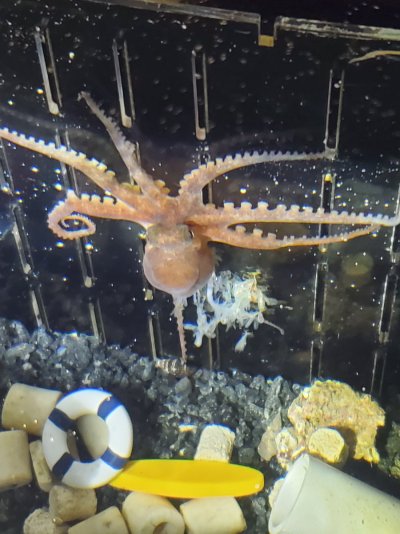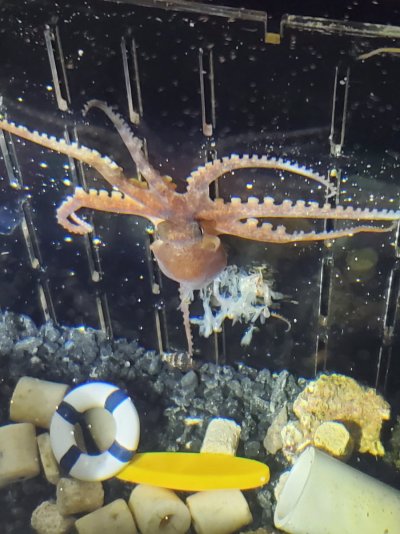Amazing process! Following along!
Navigation
Install the app
How to install the app on iOS
Follow along with the video below to see how to install our site as a web app on your home screen.
Note: This feature may not be available in some browsers.
More options
You are using an out of date browser. It may not display this or other websites correctly.
You should upgrade or use an alternative browser.
You should upgrade or use an alternative browser.
Octopus has eggs - any info or tips?
- Thread starter mc-nuggs
- Start date
-
- Tags
- eggs invert care octopus
- Tagged users None
I bought both types of shrimp in bulk orders and have been culturing them in their own tanks since Nov. 2nd.Just to make sure, are you culturing the mysid shrimp and ghost shrimp?
Egg notes and commentary, for future octopus-brood caretakers. Not my proudest post, but putting it out here so others can avoid my naive mistakes.
TLDR; If you ever see free-floating octopus eggs in your tank, don't put them in a small container with only one opening.
The octopus eggs in the previous microscope picture all died. Nugward accidentally knocked them off of the main nest while feeding 5 days ago on November 1st. I placed them in a small specimen container which I modified by cutting a large hole in the top and covered with 200 micron nylon mesh, to keep detritus out while allowing water to flow in. I'm fairly certain that they perished through hypoxia, due to not enough water flow. I placed them under the return pump jet to insure enough flow, but it seems that with only one opening, it wasn't enough.
The neglected eggs on the far side of the wall are still maturing (I can see them change color and wiggle sporatically), with absolutely no cleaning or caretaking from Nugward, so I know that lack of parental cleaning/care is not the reason for the other eggs demise. Also, the neglected wall eggs are under direct tank lighting (albeit at the bottom of the tank), so I can also rule lighting out of the equation. They are in a very low flow area, but there is consistent flow around them, and I think this is the key difference.
Also, there is still an unfertilized egg on the wall, yolk-only, which does not visibly seem to be decomposing or rotting, and it's been 3 weeks, which is surprising. I would have expected to see unfertilized eggs wasting away after one week or so.
If I could do the free-egg cluster placement over again, I would get 2 square patches of 200 micron mesh, place the eggs in the center, and glue the mesh edges together. Then I would glue a fishing line to a corner and suspend it somewhere in the tank (like steeping a teabag but with octopus eggs inside). I think this would have provided enough flow while keeping the eggs detritus-free.
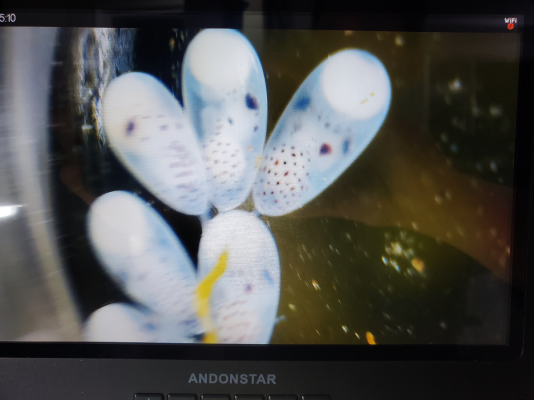
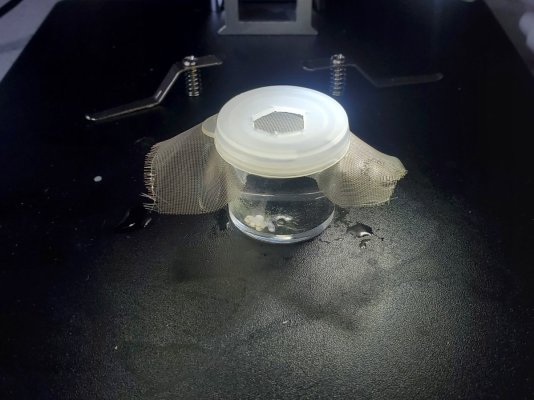
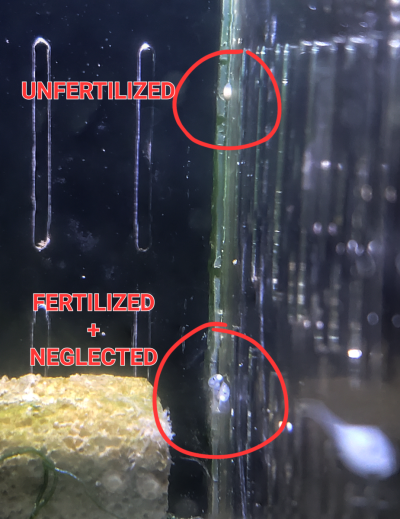
TLDR; If you ever see free-floating octopus eggs in your tank, don't put them in a small container with only one opening.
The octopus eggs in the previous microscope picture all died. Nugward accidentally knocked them off of the main nest while feeding 5 days ago on November 1st. I placed them in a small specimen container which I modified by cutting a large hole in the top and covered with 200 micron nylon mesh, to keep detritus out while allowing water to flow in. I'm fairly certain that they perished through hypoxia, due to not enough water flow. I placed them under the return pump jet to insure enough flow, but it seems that with only one opening, it wasn't enough.
The neglected eggs on the far side of the wall are still maturing (I can see them change color and wiggle sporatically), with absolutely no cleaning or caretaking from Nugward, so I know that lack of parental cleaning/care is not the reason for the other eggs demise. Also, the neglected wall eggs are under direct tank lighting (albeit at the bottom of the tank), so I can also rule lighting out of the equation. They are in a very low flow area, but there is consistent flow around them, and I think this is the key difference.
Also, there is still an unfertilized egg on the wall, yolk-only, which does not visibly seem to be decomposing or rotting, and it's been 3 weeks, which is surprising. I would have expected to see unfertilized eggs wasting away after one week or so.
If I could do the free-egg cluster placement over again, I would get 2 square patches of 200 micron mesh, place the eggs in the center, and glue the mesh edges together. Then I would glue a fishing line to a corner and suspend it somewhere in the tank (like steeping a teabag but with octopus eggs inside). I think this would have provided enough flow while keeping the eggs detritus-free.



In aquaculture of fish with pelagic eggs, we typically use an up-welling clindrically-conical tank for incubating the eggs.
Those systems are usually flow through with sea water and aeration from the bottom keeping the eggs in suspension.
The overflow is often a banjo filter using a suitable sized mesh, or just a mesh of the diameter of the tank that's positioned between the eggs and the overflow.
However, at the university we also used flat bottomed cylindrical tanks to incubate pelagic eggs and fish larvae. They had a central pipe controlling the water level and a "pipe" made from mesh around the drain pipe. They work too, but the conical ones are a little easier to clean when incubating tens of thousands of eggs.
I would use one of those artemia breeders in my sump for the abandoned octo eggs. As large as I could possibly fit. Just install a tiny pump and connect an air hose and the eggs will be moved around in clean water.
The key is stability and to not disturb the eggs as much as you can whilst maintaining adequate flow.
For hatching Sepia bandensis eggs, I've once made this contraption. This had pretty high flow with the little pump, but due to the many holes very modest pressure. The dividers were removable once the cuttlefish grew in size. For octopus something like that could also work. But instead of holes in the dividers, I'd just go with glued in mesh of a small size to keep them from escaping.

Those systems are usually flow through with sea water and aeration from the bottom keeping the eggs in suspension.
The overflow is often a banjo filter using a suitable sized mesh, or just a mesh of the diameter of the tank that's positioned between the eggs and the overflow.
However, at the university we also used flat bottomed cylindrical tanks to incubate pelagic eggs and fish larvae. They had a central pipe controlling the water level and a "pipe" made from mesh around the drain pipe. They work too, but the conical ones are a little easier to clean when incubating tens of thousands of eggs.
I would use one of those artemia breeders in my sump for the abandoned octo eggs. As large as I could possibly fit. Just install a tiny pump and connect an air hose and the eggs will be moved around in clean water.
The key is stability and to not disturb the eggs as much as you can whilst maintaining adequate flow.
For hatching Sepia bandensis eggs, I've once made this contraption. This had pretty high flow with the little pump, but due to the many holes very modest pressure. The dividers were removable once the cuttlefish grew in size. For octopus something like that could also work. But instead of holes in the dividers, I'd just go with glued in mesh of a small size to keep them from escaping.
The neglected eggs were not on the wall when I came home from work today. I looked at the aquarium ground and saw 2 which were still connected to the main "stem". No idea what happened to the other eggs. I searched the surrounding gravel and there was no sign of them. Eaten by amphipods? Stomatella snails? I noticed there is some algae growing on one of the eggs. Not sure if a snail would pierce it trying to eat algae. Seems unlikely. I didn't see any paralarvae swimming around anywhere either, so I don't think they hatched. Also, the unfertilized egg is missing.
I took the learnings from the last failed egg enclosure and I've constructed a new type of habitat which I call "tide pods" (heh). It's the same concept as a floating fish net. The mesh material is 200 micron nylon mesh which I welded shut using a 3D printing pen. The rings are styrofoam and are 2.75" outer diameter. The molten filament is hot enough to weld the mesh to the styrofoam. I'm planning on keeping some hatchlings in some of these (one per pod). I may put some activated carbon in the bottoms and try to house one or two amphipods or mysid shrimp per pod, so they don't gang up and try to eat the hatchling.
I took some microscope video of the two surviving wall-eggs (got a video capture device, so I don't have to use my phone anymore), and I've put them in a tide pod. From the fact that the egg yolk is almost visibly gone, I'm guessing that they will hatch in about a week or so.
Still worried they are all going to die in under a month, but trying to stay positive, and will update this thread regardless. I think a lot of octopus egg threads go silent b/c of the low survival rates, and most reef keepers aren't aware that marine biologists have 5% alive at 60 days post hatching.
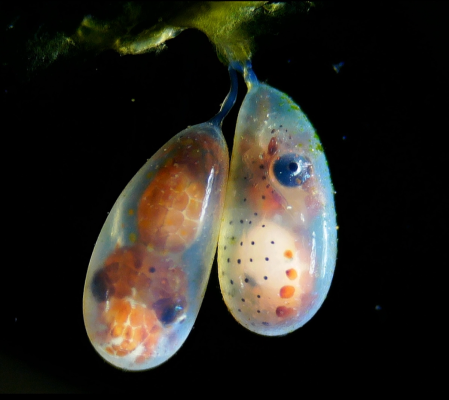
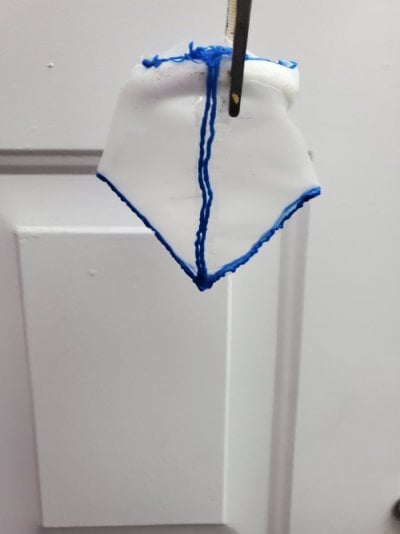
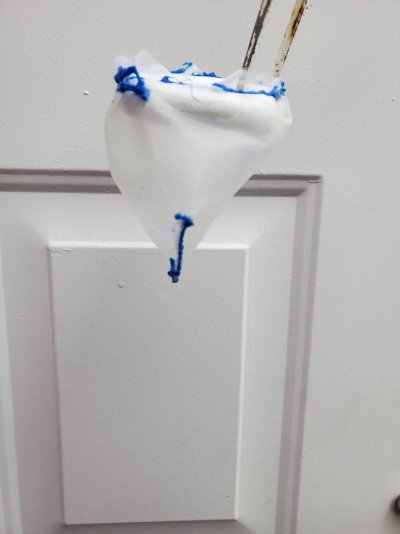
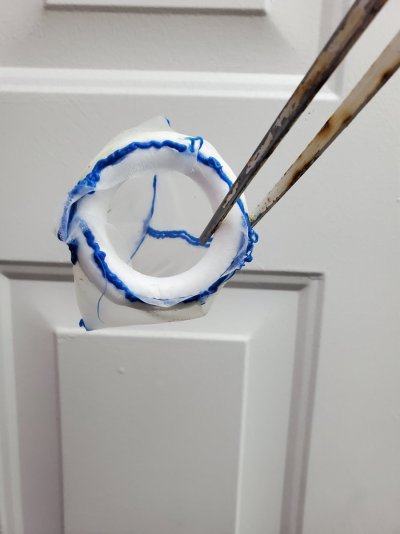
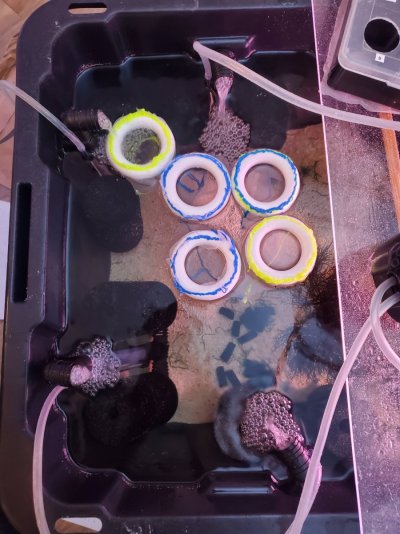
I took the learnings from the last failed egg enclosure and I've constructed a new type of habitat which I call "tide pods" (heh). It's the same concept as a floating fish net. The mesh material is 200 micron nylon mesh which I welded shut using a 3D printing pen. The rings are styrofoam and are 2.75" outer diameter. The molten filament is hot enough to weld the mesh to the styrofoam. I'm planning on keeping some hatchlings in some of these (one per pod). I may put some activated carbon in the bottoms and try to house one or two amphipods or mysid shrimp per pod, so they don't gang up and try to eat the hatchling.
I took some microscope video of the two surviving wall-eggs (got a video capture device, so I don't have to use my phone anymore), and I've put them in a tide pod. From the fact that the egg yolk is almost visibly gone, I'm guessing that they will hatch in about a week or so.
Still worried they are all going to die in under a month, but trying to stay positive, and will update this thread regardless. I think a lot of octopus egg threads go silent b/c of the low survival rates, and most reef keepers aren't aware that marine biologists have 5% alive at 60 days post hatching.





Yesterday morning (2023 NOVEMBER 13) I woke up and looked at the tank to see the first few paralarvae hopping around.
I put an order in for tig copepods and I've been breeding as many brine shrimp as possible.
They are so small, I'm pretty sure a normal ghost shrimp would eat them, maybe even the larger amphipods.
I put an order in for tig copepods and I've been breeding as many brine shrimp as possible.
They are so small, I'm pretty sure a normal ghost shrimp would eat them, maybe even the larger amphipods.
After seeing these little guys bob around the tank, I turned off my pump and have air circulation only for the time being. I have so many hatched brine shrimp in there, it looks like a snow globe. Also added phytoplankton for the brine shrimp.
Not sure how many more eggs have yet to hatch, but I would guess about half of the brood remain (20 - 30? more).
I repurposed a jellyfish tank (5 gal) I had been using to house ghost shrimp and peppermint shrimp (they were in there for like, six months) for housing extra paralarvae. There are two air stones in the back on both sides which provide circular flow, and I have a large rock column which also supports a ceiling of macro algae for nitrate removal. I added 10 paralarvae to this tank and maybe 3 mysid shrimp which I was able to catch from the other 14 gallon tote.
I have six tide pods each with a paralarvae, brine shrimp, and an amphipod inside. I ordered more mysid shrimp, as they seem the appropriate feed size. Not sure where they all went-- maybe they ate each other? They are pretty difficult to catch. Brine shrimp and copepods seem too small.
I tried feeding a paralarvae in a pod a small piece of crab at the end of a thread which I wiggled. It scuttled away from it. I may try this again soon. I think they can live off of yolk reserves for a day or two, after that they start actively looking for prey.
If any of you live near the Bay Area of California and would like to acquire some paralarvae, send me a DM. It will have to be local pickup only. There will be too many of these little guys for me to wrangle. I'll wind up having to put them all together somewhere, and they'll probably wind up eating each other.
I need to find the time to make some more tide pods. Would be nice to have a total of 10, where feeding can be directly monitored.
I will probably add any extra mysid shrimp to the jellyfish cylinder tank.
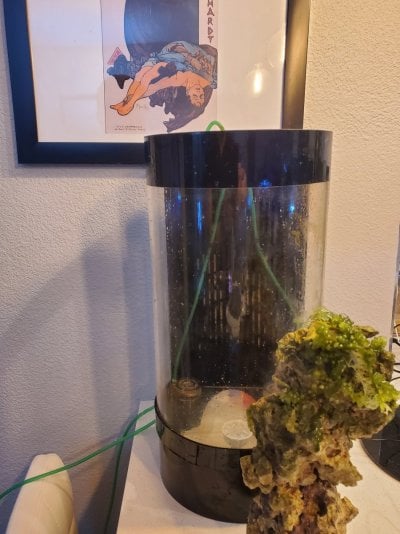
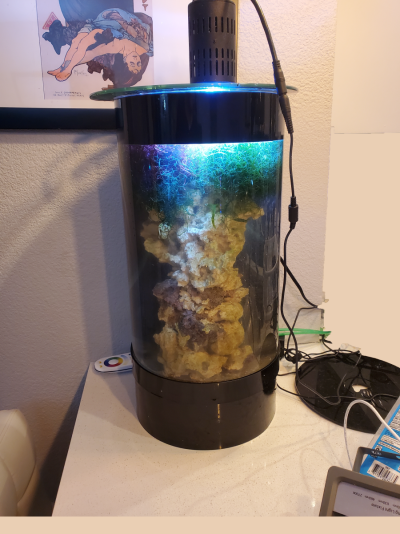
Not sure how many more eggs have yet to hatch, but I would guess about half of the brood remain (20 - 30? more).
I repurposed a jellyfish tank (5 gal) I had been using to house ghost shrimp and peppermint shrimp (they were in there for like, six months) for housing extra paralarvae. There are two air stones in the back on both sides which provide circular flow, and I have a large rock column which also supports a ceiling of macro algae for nitrate removal. I added 10 paralarvae to this tank and maybe 3 mysid shrimp which I was able to catch from the other 14 gallon tote.
I have six tide pods each with a paralarvae, brine shrimp, and an amphipod inside. I ordered more mysid shrimp, as they seem the appropriate feed size. Not sure where they all went-- maybe they ate each other? They are pretty difficult to catch. Brine shrimp and copepods seem too small.
I tried feeding a paralarvae in a pod a small piece of crab at the end of a thread which I wiggled. It scuttled away from it. I may try this again soon. I think they can live off of yolk reserves for a day or two, after that they start actively looking for prey.
If any of you live near the Bay Area of California and would like to acquire some paralarvae, send me a DM. It will have to be local pickup only. There will be too many of these little guys for me to wrangle. I'll wind up having to put them all together somewhere, and they'll probably wind up eating each other.
I need to find the time to make some more tide pods. Would be nice to have a total of 10, where feeding can be directly monitored.
I will probably add any extra mysid shrimp to the jellyfish cylinder tank.


ooo keep us updated on how this process goes. Its always fun seeing this threat pop up every now and then.
that's like only a 2 hour drive.?Omg I’m in Sacramento and would love one! There’s no way I could go down there thoughbut I will pm you!
how's Mom doing? I'm sure these little guys you'd have much longer since she laid eggs quickly.
Fun read. Hope they work out successful for you.
Yeah but a lot of gas :/ and probably a 5ish hour round trip so lots of driving and I already drive a lot doing personal shopping and food deliveriesthat's like only a 2 hour drive.?
Nugward last fed on Friday, November 10th (5 days ago), but has rejected both feeding attempts since then. She has not eaten since the first eggs started hatching. She will grab the crab meat and push it out of the nest, or blow it away with a water jet. My thinking here is that once the eggs started hatching, she went into super-mom mode.how's Mom doing? I'm sure these little guys you'd have much longer since she laid eggs quickly.
Yeah, California traffic is insane, and gas prices are 1.5x - 2x times that of other states. My work commute is only about 20 miles and it usually takes an hour b/c of traffic.Yeah but a lot of gas :/ and probably a 5ish hour round trip so lots of driving and I already drive a lot doing personal shopping and food deliveries
I've lived all over the US, and the only place which is worse is the New Jersey Turnpike and the surrounding highways leading into New York City. Phoenix/Scottsdale AZ is sometimes bad too, but not consistently so in my experience.
Feeding has not been successful. Will update in next post. Been trying to upload a video of attempted feeding.
Attachments
CT corridor Bridgeport to Stamford is the worst. Only two arteries. Merrit and 95. CA Bay Area isn’t too bad. Bought a motorcycle back then and commute was always 20 minutes. Good ole lane sharing.Nugward last fed on Friday, November 10th (5 days ago), but has rejected both feeding attempts since then. She has not eaten since the first eggs started hatching. She will grab the crab meat and push it out of the nest, or blow it away with a water jet. My thinking here is that once the eggs started hatching, she went into super-mom mode.
Yeah, California traffic is insane, and gas prices are 1.5x - 2x times that of other states. My work commute is only about 20 miles and it usually takes an hour b/c of traffic.
I've lived all over the US, and the only place which is worse is the New Jersey Turnpike and the surrounding highways leading into New York City. Phoenix/Scottsdale AZ is sometimes bad too, but not consistently so in my experience.
Feeding has not been successful. Will update in next post. Been trying to upload a video of attempted feeding.
How long is Nug by herself with you at work? Never tries escaping?
15 NOVEMBER 2023
Morning:
Woke up + checked in on the paralarvae. One of the paralarvae was dead in the tide pod. If I had to guess, the cause would be starvation (2 days old, body was in tact). There was a mysid shrimp, amphipod, and brine shrimp inside the pod with it, uneaten.
Evening:
Motivated by this discovery, I tried feeding 3 paralarvae under the microscope for observation. I tried a mysid shrimp, 2 amphipods (different sizes), a brine shrimp, and a stomatella snail larvae (not on video, resembles a flatworm).
No effect, seems like all animals tried to avoid each other. Kind of funny to see the paralarvae have visible emotions, since they flash brown/orange when they feel threatened. Also funny to see them plant their arms down, put their body into the air, and blast off. Probably helps them catch water currents.
Also tried thawed crab meat, coral aminos, pellet food. No effect.
Here is a video of the attempts. It is long, but shows what I summarized above.
Tried feeding Nugward, she rejected feeding attempts. Most of the eggs have hatched; maybe 10-20 remain?
16 November 2023 (today)
Most of the paralarvae seem to be missing in all encolures. If I had to guess, I think most of them have starved to death. I have a large order of copepods and mysid shrimp arriving tomorrow (if FedEx doesn't screw up). Will film feeding attempts again.
The rub of it is that I would be willing to feed each one of them manually if that's what it took to get them to eat. And if they only ate diamonds, well, I'd be buying diamonds by now. Really not sure what to do at this point. All suggestions welcome.
I knew the odds were against their survival, but it doesn't do much to lessen the sting of seeing them die off gradually en masse.
The brine shrimp seem to be disappearing-- will continue hatching them and hope for the best.
I tried to be as prepared as possible, not sure what I could have done different other than I would have tried to have some adult brine shrimp ready. I had some going until I added the mysid shrimp, which probably ate the large brine shrimp.
Morning:
Woke up + checked in on the paralarvae. One of the paralarvae was dead in the tide pod. If I had to guess, the cause would be starvation (2 days old, body was in tact). There was a mysid shrimp, amphipod, and brine shrimp inside the pod with it, uneaten.
Evening:
Motivated by this discovery, I tried feeding 3 paralarvae under the microscope for observation. I tried a mysid shrimp, 2 amphipods (different sizes), a brine shrimp, and a stomatella snail larvae (not on video, resembles a flatworm).
No effect, seems like all animals tried to avoid each other. Kind of funny to see the paralarvae have visible emotions, since they flash brown/orange when they feel threatened. Also funny to see them plant their arms down, put their body into the air, and blast off. Probably helps them catch water currents.
Also tried thawed crab meat, coral aminos, pellet food. No effect.
Here is a video of the attempts. It is long, but shows what I summarized above.
Tried feeding Nugward, she rejected feeding attempts. Most of the eggs have hatched; maybe 10-20 remain?
16 November 2023 (today)
Most of the paralarvae seem to be missing in all encolures. If I had to guess, I think most of them have starved to death. I have a large order of copepods and mysid shrimp arriving tomorrow (if FedEx doesn't screw up). Will film feeding attempts again.
The rub of it is that I would be willing to feed each one of them manually if that's what it took to get them to eat. And if they only ate diamonds, well, I'd be buying diamonds by now. Really not sure what to do at this point. All suggestions welcome.
I knew the odds were against their survival, but it doesn't do much to lessen the sting of seeing them die off gradually en masse.
The brine shrimp seem to be disappearing-- will continue hatching them and hope for the best.
I tried to be as prepared as possible, not sure what I could have done different other than I would have tried to have some adult brine shrimp ready. I had some going until I added the mysid shrimp, which probably ate the large brine shrimp.
Looking at the video, I’d guess the prey items you offered there are just too big (while the octopus itself is relatively large, it’s actual mouth is likely quite tiny, and even if the octopus can consume these, taking them down would probably take a lot of energy, which most larvae try to preserve); if possible, I’d suggest offering larvae (of various sizes from freshly hatched onward) from the mysids and the pods to see if you can get a different response. If that doesn’t work, then the copepods/copepod nauplii are probably your best bet.I tried a mysid shrimp, 2 amphipods (different sizes), a brine shrimp, and a stomatella snail larvae (not on video, resembles a flatworm).
Remember, for most larvae in the hobby, the feeders that work for them need to:
- Be the right size to be consumed
- Move the right way to elicit a feeding response
- Be palatable to the larvae
- Be nutritious to the larvae for the stage of life they’re being offered at
Great info you’re getting, though, and I hope the larvae and/or pods work for you.
something I noticed from your video.15 NOVEMBER 2023
Morning:
Woke up + checked in on the paralarvae. One of the paralarvae was dead in the tide pod. If I had to guess, the cause would be starvation (2 days old, body was in tact). There was a mysid shrimp, amphipod, and brine shrimp inside the pod with it, uneaten.
Evening:
Motivated by this discovery, I tried feeding 3 paralarvae under the microscope for observation. I tried a mysid shrimp, 2 amphipods (different sizes), a brine shrimp, and a stomatella snail larvae (not on video, resembles a flatworm).
No effect, seems like all animals tried to avoid each other. Kind of funny to see the paralarvae have visible emotions, since they flash brown/orange when they feel threatened. Also funny to see them plant their arms down, put their body into the air, and blast off. Probably helps them catch water currents.
Also tried thawed crab meat, coral aminos, pellet food. No effect.
Here is a video of the attempts. It is long, but shows what I summarized above.
Tried feeding Nugward, she rejected feeding attempts. Most of the eggs have hatched; maybe 10-20 remain?
16 November 2023 (today)
Most of the paralarvae seem to be missing in all encolures. If I had to guess, I think most of them have starved to death. I have a large order of copepods and mysid shrimp arriving tomorrow (if FedEx doesn't screw up). Will film feeding attempts again.
The rub of it is that I would be willing to feed each one of them manually if that's what it took to get them to eat. And if they only ate diamonds, well, I'd be buying diamonds by now. Really not sure what to do at this point. All suggestions welcome.
I knew the odds were against their survival, but it doesn't do much to lessen the sting of seeing them die off gradually en masse.
The brine shrimp seem to be disappearing-- will continue hatching them and hope for the best.
I tried to be as prepared as possible, not sure what I could have done different other than I would have tried to have some adult brine shrimp ready. I had some going until I added the mysid shrimp, which probably ate the large brine shrimp.
1) they generally like high flow and you're feeding them in stagnant water essentially to observe. you might want to try leaving them in the pods you made in the flow of the aquarium with some artemia inside them. they could just be stressed being in that low flow environment with this giant eyeball above them. the water may also become warm very quickly due to the small amount unless you're in a refrigerated room.
2) you are observing them under a microscope under lights, try shutting the lights out for their nocturnal hunting behavior. or use a dim red if you want to see what's going on.
if you haven't, I'd try and leave a few alone in the tank and maybe a few in a mesh breeding basket in the tank. dump some decapods in both.
this really is a great read. please keep it up.
Similar threads
- Replies
- 8
- Views
- 350
- Replies
- 3
- Views
- 242
- Replies
- 11
- Views
- 717








